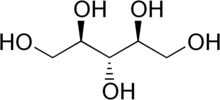
| |
| Names | |
|---|---|
| IUPAC name D-Ribitol | |
| Systematic IUPAC name (2R,3S,4S)-Pentane-1,2,3,4,5-pentol | |
| Other names
(2R,3S,4S)-Pentane-1,2,3,4,5-pentaol (not recommended) Adonit Adonite Adonitol Adonitrol Pentitol 1,2,3,4,5-Pentanepentol 1,2,3,4,5-Pentanol Pentane-1,2,3,4,5-pentol | |
| Identifiers | |
| CAS Number | |
| 3D model (JSmol) | |
| Beilstein Reference | 1720524 |
| ChEBI | |
| ChEMBL | |
| ChemSpider | |
| ECHA InfoCard | 100.006.987 |
| EC Number |
|
| Gmelin Reference | 82894 |
| KEGG | |
| PubChem CID | |
| UNII | |
| CompTox Dashboard (EPA) | |
InChI
| |
SMILES
| |
| Properties | |
| Chemical formula | C5H12O5 |
| Molar mass | 152.146 g·mol |
| Melting point | 102 °C (216 °F; 375 K) |
| Magnetic susceptibility (χ) | -91.30·10 cm/mol |
| Except where otherwise noted, data are given for materials in their standard state (at 25 °C , 100 kPa).
| |
Ribitol, or adonitol, is a crystalline pentose alcohol (C5H12O5) formed by the reduction of ribose. It occurs naturally in the plant Adonis vernalis as well as in the cell walls of some Gram-positive bacteria, in the form of ribitol phosphate, in teichoic acids. It also forms part of the chemical structure of riboflavin and flavin mononucleotide (FMN), which is a nucleotide coenzyme used by many enzymes, the so-called flavoproteins.
References
- "2-Carb-19".
- Advances in Applied Microbiology. Academic Press. 28 October 1997. ISBN 9780080564586.
- Seltmann, Guntram; Holst, Otto (9 March 2013). The Bacterial Cell Wall. Springer Science & Business Media. ISBN 9783662048788.
- Mathews, Christopher K. (2000). Biochemistry. Van Holde, K. E. (Kensal Edward), 1928-, Ahern, Kevin G. (3rd ed.). San Francisco, Calif.: Benjamin Cummings. p. 492. ISBN 0805330666. OCLC 42290721.
External links
 Media related to Ribitol at Wikimedia Commons
Media related to Ribitol at Wikimedia Commons- GMD MS Spectrum
- Safety MSDS data Archived 11 October 2007 at the Wayback Machine
- Biological Magnetic Resonance Data Bank
This article about an alcohol is a stub. You can help Misplaced Pages by expanding it. |